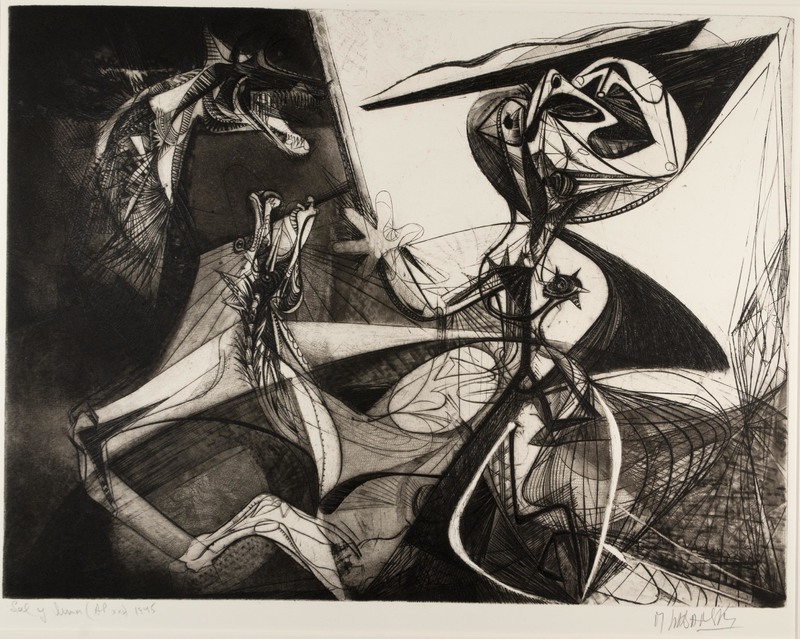Sol y Luna
Item
Title
Sol y Luna
Creator
Mauricio Lasansky
American, b. Argentina, 1914
American, b. Argentina, 1914
Date
1945
Materials
Engraving, soft-ground etching, aquatint, and gauffrage with scraping and burnishing
Measurements
Plate: 15-7/8 x 20-13/16 in. (40.2 x 52.9 cm), sheet: 19 x 22-7/8 in. (48.2 x 60.7 cm)
Description
Mauricio Lasansky is one of the very few artists in modern times to focus almost exclusively on printmaking. Although he trained in numerous media while attending the Superior School of Fine Arts in Buenos Aires, his hometown, by the age of nineteen he had already settled on the graphic arts as the direction for his career. In 1943, he won a Guggenheim Fellowship to study the print collection at The Metropolitan Museum of Art, and within a few months of his arrival in New York, S. W. Hayter invited him to join Atelier 17. In no time, the poetic, perhaps mildly Surrealist quality that marked his earlier efforts, executed mostly in etching and drypoint, gave way to an intensive, more immediately expressive engraving that was characteristic of the Atelier 17 aesthetic. Like a number of artists in residence, Lasansky was drawn in particular to Picasso’s emotionally charged Guernica period, and echoes of its imagery can be found in nearly everything he produced while associated with the studio.
In content and form, bearing not surprisingly many of the workshop’s key innovations, Sol y Luna is thoroughly representative of Lasansky’s work during his Atelier 17 tenure. The violently engraved battle of white and black taking place within its margins, clearly intended to resonate with the antithetical struggle to which the title alludes—sun versus moon, day facing night, good versus evil—can also be read in terms of the more pertinent conflict playing out its final year on the world’s stage: World War II.
Sol y Luna was among the last of Lasansky’s Atelier 17 efforts. In 1945, he accepted an invitation to teach at the University of Iowa, where over the course of the next decade he established one of the most dynamic graphic art departments in the country. The Iowa Print Group, as the studio was first called, served as a model for numerous other university printmaking departments, many of which were established and run by Lasansky’s former students. Lasansky retired in 1985, but his legacy remains. The Iowa workshop regularly ranks as one of the top printmaking programs in the United States.
In content and form, bearing not surprisingly many of the workshop’s key innovations, Sol y Luna is thoroughly representative of Lasansky’s work during his Atelier 17 tenure. The violently engraved battle of white and black taking place within its margins, clearly intended to resonate with the antithetical struggle to which the title alludes—sun versus moon, day facing night, good versus evil—can also be read in terms of the more pertinent conflict playing out its final year on the world’s stage: World War II.
Sol y Luna was among the last of Lasansky’s Atelier 17 efforts. In 1945, he accepted an invitation to teach at the University of Iowa, where over the course of the next decade he established one of the most dynamic graphic art departments in the country. The Iowa Print Group, as the studio was first called, served as a model for numerous other university printmaking departments, many of which were established and run by Lasansky’s former students. Lasansky retired in 1985, but his legacy remains. The Iowa workshop regularly ranks as one of the top printmaking programs in the United States.
Source
Palmer Museum of Art, The Pennsylvania State University
Identifier
2010.1
Rights
This image is posted publicly for non-profit educational uses, excluding printed publication. Other uses are not permitted.

